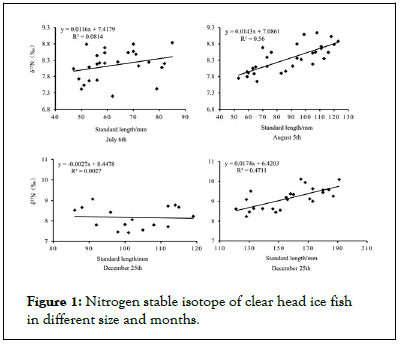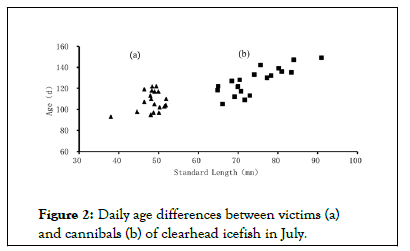Fisheries and Aquaculture Journal
Open Access
ISSN: 2150-3508
ISSN: 2150-3508
Short Communication - (2022)Volume 13, Issue 4
Transition to feed on fish and cannibalism seems to increase the fitness of fish in the view of evolution, and evidences that diet shifting to fish increased growth and survival rate of fish have been provided two decades age [1,2]. While there wasn’t direct evidence of increasing the fitness of reproduction by cannibalism or piscivory until Tang et al. published their papers on an annual fish, clearhead icefish (Protosalanx chinensis) in recent years [3,4]. In their paper, they found some bigger individuals can transition to feed on fish while the smaller individuals didn’t transition to feed on fish but feed on zooplankton through gut content analysis [3]. After that, we determined the nitrogen stable isotope ratio of this fish of different size in the same samples, and didn’t find the trophic position elevated in early July although some larger individuals began transition to feed on fish, but confirmed the elevation of cannibal trophic position since august which is consistent to the gut content analysis [3]. The cannibalism occurred since July [4]. We determined the age of the cannibals and victims using otolith daily rings, and found the cannibals are early birth ones (Paired samples T-test, P<0.001). This means cannibalism will drive the fish to evolve to early spawning and increase size, which may be the evolutionary mechanism of this fish spawning in winter.
Tang et al. also mentioned that the lower modal males made up the majority of the population after the spawning period due to the death after spawning, which meant they have few opportunities to participate in reproduction [4].
All above contribute to fish evolve to be bigger, which is an evidence from living creature for “the cope’s rule”.
The small and medium individuals in the whitebait population provide an important bait basis for the large individuals to stably feed on fish. The difference in body length between the predators and the prey in Xingkai Lake in 2010 is shown in Figure 1. The body length of the prey was less than 120 mm in all months, and the ratio of the body length of the prey to the predator in July, October, November and December was similar and higher, ranging from 0.49 to 0.70, and the mean was not less than 0.60; the second in August, between 0.47 and 0.64, with an average value of 0.57; the lowest in September, between 0.48 and 0.54, with an average value of 0.51. The otolith age analysis showed that most of the small individuals that were eaten were born later than the predators, and only a few small individuals were about the same age as the large individuals (Figure 2). It was significantly larger than that of the eaten, and the difference was extremely significant (P<0.001). Therefore, early birth and fast growth rate are the 2 main factors for big whitebait to become predators, and early birth is more important.

Figure 1: Nitrogen stable isotope of clear head ice fish in different size and months.

Figure 2: Daily age differences between victims (a) and cannibals (b) of clearhead icefish in July.
On July 4, the age range of the predators was 105-149 days, and the age range of the prey was 95-132 days. The average age of the predators was significantly larger than that of the prey, and the difference between the two was extremely significant (ANOVA, F1, 38=22.73, P<0.001); the age composition of predators and prey is shown in Figure 1. Predator birth dates are presumed to be February 9 to March 21, and prey birth dates to be February 26 to April 1.
P. chinensis is a small fish with a short life span and high fertility that develops early. This distinguishes it from winemiller and rose's suggested three-point life-history continuum model. Larger people have a more opportunistic life-history approach, but with higher fertility. In regularly changing or unpredictable conditions, an opportunistic colonization strategy allows an invading species to expand its range by maturing early.
Citation: Tang F (2022) Evidence from Living Creature: The Cope’s Rule. Fish Aqua J. 13:304.
Received: 03-Jun-2022, Manuscript No. FAJ-22-17441; Editor assigned: 08-Jun-2022, Pre QC No. FAJ-22-17441 (PQ); Reviewed: 22-Jun-2022, QC No. FAJ-22-17441; Revised: 30-Jun-2022, Manuscript No. FAJ-22-17441 (R); Published: 07-Jul-2022 , DOI: 10.35248/2150-3508.22.13.304
Copyright: © 2022 Tang F. This is an open-access article distributed under the terms of the Creative Commons Attribution License, which permits unrestricted use, distribution, and reproduction in any medium, provided the original author and source are credited.